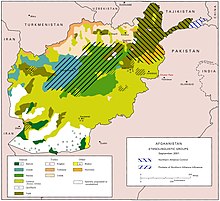Khost Province
Khost
خوست | |
|---|---|
 A village in the Nadir Shah Kot District of Khost Province | |
 Map of Afghanistan with Khost highlighted | |
| Coordinates (Capital): 33°24′N 69°54′E / 33.4°N 69.9°ECoordinates: 33°24′N 69°54′E / 33.4°N 69.9°E | |
| Country | Afghanistan |
| Capital | Khost |
| Government | |
| • Governor | Mohammad Nabi Omari[1] |
| Area | |
| • Total | 4,151.5 km2 (1,602.9 sq mi) |
| Population (2021)[2] | |
| • Total | 647,730 |
| • Density | 160/km2 (400/sq mi) |
| Time zone | UTC+4:30 (Afghanistan Time) |
| Area code(s) | AF-KHO |
| Main languages | Pashto |
Khost (Pashto/Dari: خوست) is one of the 34 provinces of Afghanistan, located in the eastern part of the country. To the east, Khost Province is bordered by North Waziristan and Kurram in Pakistan. Khost Province used to be part of Paktia Province in the past, and the larger region surrounding Khost is still called Loya Paktia ("Greater Paktia").
The city of Khost serves as the capital of Khost province. The population of the province is around 647,730,[2] which is mostly a tribal society. Khost Airport serves the province for domestic flights to Afghanistan's capital, Kabul.
In 2021, the Taliban gained control of the province during the 2021 Taliban offensive.
History[]
| History of Afghanistan |
|---|
 |
| Timeline |
| Related historical names of the region |
| Related topics |
|
In 1924, Khost Province, then known as Southern Province, was the scene of a rebellion by the Mangal Pashtun Tribe, known as the Khost rebellion. The rebellion was ultimately unsuccessful, and was defeated in 1925 by the Afghan Government. Khost was part of Paktia Province until 1985, when the People's Democratic Party of Afghanistan regime made it a separate province.[3]
Khost Province saw the Battles of Zhawar and part of Operation Infinite Reach.
Healthcare[]
The percentage of households with clean drinking water increased from 34% in 2005 to 35% in 2011.[4] The percentage of births attended to by a skilled birth attendant increased from 18% in 2005 to 32% in 2011.[4]
Education[]
The overall literacy rate (6+ years of age) fell from 28% in 2005 to 15% in 2011.[4] The overall net enrolment rate (6–13 years of age) fell from 38% in 2005 to 37% in 2011.[4]
Demographics[]

As of 2021, the population of the province is around 950,000 people.[2][5] Other sources put the number at over a million.[6]
The Pashtun people make up 99% of the population, with the remaining 1% being Tajiks and others.[7]
Districts[]
| District | Capital | Population (2015) | Area[8] | Notes |
|---|---|---|---|---|
| Bak | 50,000 | |||
| Gurbuz | 45,000 | |||
| Zazi Maidan | 70,000 | |||
| Khost Matun | Khost | 140,642 | ||
| Mandozayi | Dadwal | 89,602 | ||
| Musakhel | 41,882 | |||
| Nadir Shah Kot | 47,000 | |||
| Qalandar | 20,000 | |||
| Sabari | Yakubi | 72,364 | ||
| Shamal | 34,000 | Shifted from Paktia Province in 2005 | ||
| Spera | 45,000 | |||
| Tani | Tani | 60,842 | ||
| Tirazayi | Aliser | 45,602 |
Water[]
Khost Province is traversed by the Kurram River, which rises from the , passes through the district, and then enters the "country of the Turis or the Kurram Valley".[9]
Gallery[]

Khost, the capital of Khost province

Afghan children

A U.S. Marine, assigned to Weapons Company, 3rd Battalion, 3rd Marine Regiment, provides security while in the Khost-Gardez Pass (December 2004)

U.S. soldiers during a mission (June 2013)

U.S. soldiers during a mission in Tanio area (May 2012)
See also[]
- Battle for Hill 3234
- Forward Operating Base Chapman attack
- Forward Operating Base Salerno
References[]
- ^ "Taliban appoints former Guantanamo Bay detainee released under Obama to leadership post in Afghanistan". news.yahoo.com. Retrieved 2021-09-19.
- ^ Jump up to: a b c "Estimated Population of Afghanistan 2021-22" (PDF). nsia.gov.af. National Statistic and Information Authority (NSIA). April 2021. Retrieved June 30, 2021.
- ^ Thomas Ruttig (2009). "Loya Paktia's Insurgency: The Haqqani Network as an Autonomous Entity" (PDF). Retrieved 6 August 2020.
- ^ Jump up to: a b c d Archive, Civil Military Fusion Centre, https://www.cimicweb.org/AfghanistanProvincialMap/Pages/Khost.aspx Archived 2014-05-31 at the Wayback Machine
- ^ "Settled Population of Khost province by Civil Division, Urban, Rural and Sex-2012-13" (PDF). Islamic Republic of Afghanistan: Central Statistics Organization. Retrieved 2014-01-18.
- ^ On the Road - Khost Province Season 1 (Pashto) on YouTube, Feb 13, 2012, TOLO/USAIDAfghanistan.
- ^ "Khost Province" (PDF). Program for Culture & Conflict Studies. Naval Postgraduate School. Retrieved 2014-01-18.
- ^ Afghanistan Geographic & Thematic Layers
- ^ Imperial gazetteer of India: provincial series, Volume 20. Publisher Supt. of Govt. Print., 1908
- Blowback: The Costs and Consequences of American Empire, by Chalmers Johnson, ISBN 0-8050-6239-4
- "Ghost Wars"
External links[]
| Wikimedia Commons has media related to Khost Province. |
- Travel on YouTube, November 12, 2015, Shamshad TV.
- On the Road - Khost Province Season 1 (Pashto) on YouTube, Feb 13, 2012, TOLO/USAIDAfghanistan.
- Khost Province by the Naval Postgraduate School
- Khost Province by the Institute for the Study of War
- Khost Province
- Provinces of Afghanistan
- Provinces of the Islamic Republic of Afghanistan







